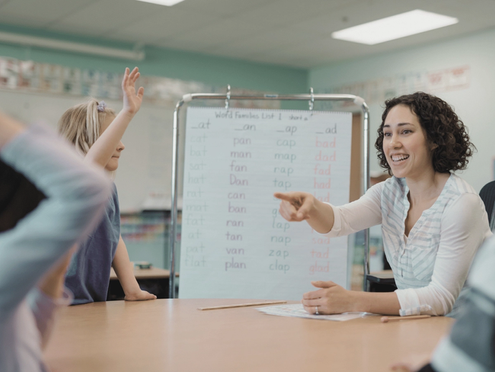What are podcasts? And why is everyone talking about them?
Podcasts come in a variety of forms but are typically defined as a series of digital audio programmes that focus on a specific topic or theme. They are distributed both online, through websites and blogs, and most notably through music streaming platforms, such as Spotify and Apple Music. Most, like a radio show, are episodic. Some, like audiobooks, tell a standalone story.
While podcasting has been around since the early 2000s, its popularity has surged in the last decade. With more than 2.4 million podcasts now available globally – and hundreds of millions of listeners worldwide – podcasting is now a part of everyday life for many people.
Despite this popularity, podcasts are still underutilised in the classroom. This may be because some teachers worry that replacing traditional written learning aids with audio may detract from literacy skills. Research does show that listening alone can lead to higher levels of distraction or less interest in the subject material than reading.
However, this doesn’t tell the whole story! There’s also plenty of evidence that podcasts can be used to improve literacy and aid teaching. It’s all a question of how you use them.
How can podcasts improve literacy?
Even outside the classroom, podcasts are a great tool for improving literacy.
On a basic level, there are dozens of podcasts dedicated to literacy and books. These give learners (plus parents and teachers) a simple way to discover new stories and discussions about literacy, offering a free and easily accessible alternative to print books.
In addition, since podcasts are audio rather than image-based, listening to a story via a podcast can encourage children to use their imagination. And engaging with a wide range of stories can also help learners to develop their skills as storytellers.
But the benefits of podcasts aren’t limited to those explicitly about literacy or storytelling. More generally, podcasts are great for inspiring curiosity and enhancing listening skills.
Podcasts can inspire curiosity
Podcasts are a brilliantly accessible way of introducing new topics to learners. Listening to a podcast can therefore inspire learners to do some extra reading. Research by the Literacy Trust, for example, shows that young people who listen to podcasts are more likely to enjoy reading (47.8% vs 40.8%) and read daily (30.4% vs 27.0%) than those who don’t.
Podcasts enhance listening skills
Perhaps the most important way in which podcasts can boost literacy is by helping learners to build listening and comprehension skills. Key factors include:
- Being an audio medium, following an episode of a podcast requires the listener to engage actively and focus on what the speakers are saying. This can even be valuable for older learners such as students who are preparing for university, where they may need to focus on long lectures.
- Podcasts can be quite conversational in style, often involving multiple speakers, which makes them distinct from many written resources (and even traditional audiobooks). Due to this, they give learners a chance to experience different communication styles and voices while listening.
- Interviews with specialists in a subject area can be a great way of introducing new vocabulary and learning how to communicate like an expert.
- The value of listening skills for literacy is also backed up by academic research.
Hogan, Adlof and Alonzo (2014), for example, have argued for a greater emphasis on the importance of listening comprehension in teaching literacy, stating that “[w]hile assessments and interventions for decoding [word recognition] have been the focus of pedagogy in the past several decades … listening comprehension becomes the dominating influence on reading comprehension even at a young age.”
Thus, insofar as podcasts enhance listening comprehension, they can also provide a basis for learners to develop further literacy skills from an early age.
Why should I be teaching with podcasts in the classroom?
You might already listen to some of the many podcasts aimed at teachers. But podcasts are increasingly catching on as a classroom resource, too. Why is this?
Ultimately, it comes down to three main factors: engagement, building confidence and accessibility.
1. Students love podcasts
Podcasts, as mentioned above, are a massively popular medium at the moment. This makes them a great way of engaging literacy learners in the classroom.
Teacher Michael Godsey, for example, has written about the success he had using Serial in classrooms. He found that even compared to audiobooks, students were more likely to engage with podcasts without getting distracted. And when he asked his students whether they’d rather read a book together or study another podcast and use that as the basis for more reading and writing exercises, just one student voted for reading the book.
Using podcasts can also be a handy way to get an entire class to engage in an activity without requiring each student to have their own device or screen.
2. Reading along with podcasts can build confidence
One mistake often made by critics of podcasts in the classroom is assuming that they’re replacing books and other print resources. But this doesn’t have to be the case!
Rather, many podcasts now publish transcripts for each episode. This means teachers can ask students to read along while listening to a podcast, which offers several benefits:
- Students can practise their listening comprehension while using the accompanying transcript to check that they’re following the audio correctly.
- Reading and listening at the same time requires more active engagement.
- Learners can use the transcript to review anything they miss in the audio.
- Young learners and students learning English as a second language can hear how new words are pronounced at the same time as reading them.
- Reading along to audio can help easily distracted learners focus.
The combination of listening and reading can be especially effective for learners who struggle to concentrate on written texts alone, such as people with ADHD or dyslexia.
However, following along to a podcast can help all learners build confidence as readers.
3. Podcasts are free and readily accessible
Finally, unlike many classroom resources, podcasts are free and readily accessible.
All you need to use podcasts is an internet connection and a device to play them. This makes podcasts a cheap, effective tool to build lessons around. Since most students will also have access to podcasts at home, teachers can recommend episodes related to topics covered in class to help inspire further learning and reading.
In addition, you can find podcasts of all types – and for all ages – on almost every subject imaginable. So, whether you’re looking for a serious history lecture, a light-hearted conversation about current events, a short story for children, or whatever topic you’re currently teaching, you should be able to find a podcast to fit your goals.
How can I get the most out of podcasts in my teaching?
As with introducing any form of technology into the classroom, how you do so will require time and effort on your behald. The most effective way to use podcasts in your teaching will depend on various factors – how old the students are, their existing literacy skills, etc. But some general tips can be applied in many situations, including:
- Give students a chance to read along – As noted above, students tend to get the most out of podcasts when they can read along as well. Where possible, make sure to share the podcast transcript with students. Luckily, many podcasts now come with transcripts. But you can also use transcription software to generate a transcript if none is available via the podcast website.
- Provide worksheets – Giving learners worksheets to fill in is another way to encourage engagement and active listening. Some podcasts even provide resources to use in the classroom, so make sure to check (e.g. the ethics podcast Short and Curly comes with classroom resources for learners aged 8 to 12).
- Use podcasts to prompt conversation – After listening to a podcast or excerpt, think about how you can use it to prompt classroom conversion. You could encourage learners to roleplay their own “interview”, with one student asking questions on the topic and another being the “expert” interviewee, giving them a chance to use what they’ve heard and practise speaking skills.
- Encourage learners to create “sketchnotes” – If you’re not keen on asking students to read along to a podcast, you could ask them to make “sketchnotes” instead. This refers to doodling images alongside making notes, which helps learners to engage visually and maintain focus while they listen to a podcast.
- Hand out one-page overviews – When planning a lesson based on listening to a podcast, providing a one-page summary of the key points covered in the form of a knowledge organiser will help students to consolidate what they’ve learned. This can also be a great place to recommend further reading (or listening!) based on the lesson topic.
If you’re feeling ambitious, you could even set up a class podcasting project. This could involve asking students to pick a topic, write a script and interview one another (or local guests), giving them opportunities to practise a whole range of skills. Admittedly, you might have to do a bit of the editing yourself, but this is easier than you might think.
How Bedrock uses human narration to improve literacy learning
As with the benefits of reading along with a podcast, Bedrock’s core curriculum uses human narration alongside bespoke fiction and nonfiction prose to improve literacy learning.
Everything from the prose itself, new vocabulary, activity feedback, synonyms and recap tasks is narrated by real humans, encouraging learners to read along with the text and engage more deeply with written content. This improves reading comprehension and long-term retention of new literacy skills.
As well as this, the benefits of human narration are combined with visual cues in Bedrock’s teaching videos, designed by experts to teach basic and advanced elements of English grammar.
Where podcasts can be an excellent classroom tool for improving literacy learning, the benefits of dual-coded learning are individualised and personalised through Bedrock’s Alpha test and holistic assessment. This saves teachers time finding powerful human-narrated literacy content and allows them to track literacy progress over time.





